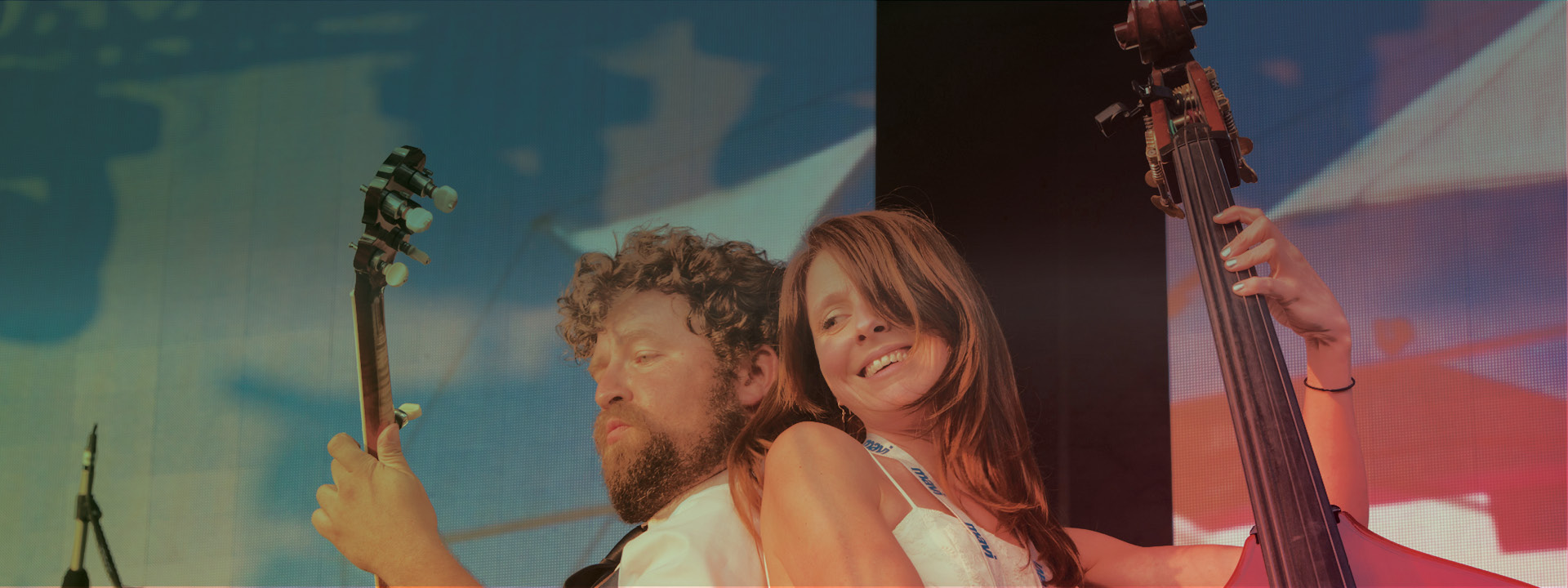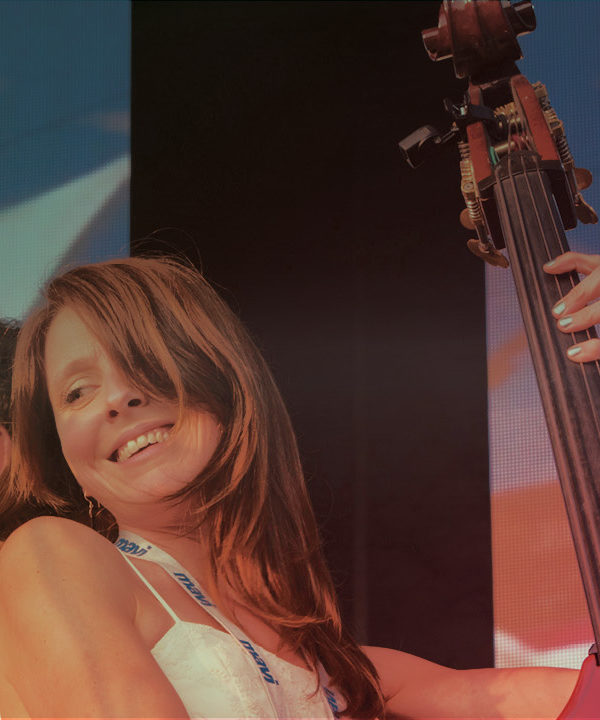Mariposa to Stardom

Source: Mariposa Folk Foundation
The roster of musicians who’ve played the Mariposa Folk Festival would fill a fine collection of traditional vinyl or a stellar Spotify playlist. Many of them were diamonds in the rough when they first appeared at Mariposa, playing this festival long before they became well-known. They contribute to a long tradition of musicians who made stops at Mariposa on their way to stardom.
1960s: Ever Hear of Leonard Cohen or Buffy Sainte-Marie?
In the lead-up to the first Mariposa Folk Festival, a young duo from Orillia auditioned for a chance at folk stardom. “Sorry,” they were told, “you sound too much like the Everly Brothers.” The group, called the Two Tones, was comprised of local boys Gordon Lightfoot and Terry Whelan. The backhanded compliment didn’t deter young Mr. Lightfoot, who a year later managed to break into the line-up of the 1962 festival. In 1964, when the festival miraculously survived and transferred to Toronto, Lightfoot introduced one of his new songs, a ditty called “Early Morning Rain.” The magical recording of that song still exists.
The same year Lightfoot appeared at the 1964 Maple Leaf Stadium festival, a young Cree singer-songwriter also made an impression. Buffy Sainte-Marie was the hit of that gathering, and it helped launch her to a successful career that has lasted to this day. Her songs “Universal Soldier” and “Until It’s Time For You To Go” echoed through the festival that year and soon were picked up and recorded by the likes of Donovan and Neil Diamond. Grammy awards and an Oscar were still in her future, but the folks at Mariposa got to see Buffy Sainte-Marie before she was a household name.

Source: Mariposa Folk Foundation
The following year the festival settled in a spot amid the Caledon Hills. Estelle Klein hired a young woman from Saskatchewan named Joni Anderson. As good and as popular as she was, Klein felt a need to admonish the singer because she repeated the same five songs in every performance. Anderson, who’d soon take on her married name of Mitchell, was told in no uncertain terms to expand her repertoire. Apparently she did, because Joni Mitchell was invited back for the next four years, even as she exploded onto the American popular music scene with “Both Sides Now,” “Circle Game,” and “Big Yellow Taxi.”
In 1967 at Innis Lake, festivalgoers were introduced to a young poet and novelist from Montreal who had decided to add a third tool to his creative belt—that of folk singer. Leonard Cohen’s songwriting would become legendary. “Suzanne” had already hit the charts for Noel Harrison and Judy Collins; other Cohen songs such as “Famous Blue Raincoat” and “Hallelujah” were far in the future, but Cohen demonstrated his early material to a Mariposa audience in the days before most people realized he sang and played guitar.
In the late 60s and early 70s, another pair of Canada’s finest songwriters appeared at Mariposa before they became well-known elsewhere. Murray McLauchlan planted himself first as a volunteer and then a performer. Luck put him on a Mariposa stage with well-established Boston folkie Tom Rush. Rush was so taken with two of McLauchlan’s songs—“Child’s Song” and “Old Man Song”—that he recorded them for his self-titled album Tom Rush. Rush also helped the careers of Joni Mitchell, David Wiffen, and Jackson Browne by recording their songs as well.
1970s: “The Cool Place to Be”
James Taylor was on the brink of stardom in 1970. He’d been signed to the Beatles’ Apple label a couple of years earlier, but his first album had stalled on the folk and popular music charts. His 1970 album Sweet Baby James was about to hit the stratosphere. Then-girlfriend Joni Mitchell told Taylor about Mariposa, “It’s the cool place to be,” she said, and although Estelle Klein used a tight-budget, to hire him, he signed and was one of the hits of the festival that year. Within six months he was a genuine superstar with his face on the cover of Time magazine. Foresight? Luck? Happenstance? Mariposa presented a skyrocket as it was about to take-off.
Leon Redbone was one of the most enigmatic characters ever to appear at Mariposa. In 1972 Redbone was scheduled to play the festival for the second time. His notoriety had spread to such an extent that Bob Dylan made a trip to Toronto and the Mariposa Folk Festival specifically to see Leon. The fuss caused, and the mythology built around that visit is legendary in folk music circles. Redbone went on to have a solid if uneven career, but his reputation as a “musician’s musician” led to 13 studio albums as well as live and compilation recordings.

Source: Mariposa Folk Foundation
At the same 1972 Mariposa Folk Festival where Dylan dropped in to see Redbone, one of the greatest American blues singers made her first appearance at the festival. Bonnie Raitt, just beginning her career, wowed the audiences on the various stages around Toronto Island. According to insiders, she was also the hit among fellow musicians as she went from after-party to after-party, to show off her incredible voice and equally impressive guitar skills.
In 1975 a tall young man impressed audiences every time he stepped up to a microphone. With a booming baritone voice, songs that were jaw-dropping good, and a stage presence few could match, Stan Rogers showed Mariposa audiences what it would take others years to see. Stan played the festival three more times, building a reputation that eventually gained him nationwide recognition. Tragically he died in 1983, and it was only posthumously that his fame spread. Estelle Klein saw the greatness long before many others, and made sure he was an element of those classic Mariposa festivals on Toronto Island.
1990s to Now: Festival Sensations, Exploding Careers

Source: Mariposa Folk Foundation
Every year the artistic director of Mariposa is inundated with requests from prospective performers. They come in all forms: emails, letters, CDs, vinyl records, digital recordings. Few can be acknowledged, let alone heard and assessed. In 1991 Richard Flohil, a seasoned purveyor of all things folk and blues, was the artistic director and tape cassettes were the choice for submissions. Flohil admitted that he only ever hired two acts without having seen them. One was a dud, a singer from New York State who did not live up to his taped audition. The other was a case of—to use the sports analogy—hitting it out of the park. Ani DiFranco, an unknown singer from Buffalo, impressed Flohil with her cassette. He put her on the Mariposa stages in 1991 and 1992. Testament to Flohil’s insight and eye for talent, DiFranco’s career exploded. Every artistic director of Mariposa has similar success stories.
A band from Peterborough, Ontario played Mariposa in 2002. With them came a teenaged friend with songwriting chops that belied her age and a voice so powerful it astounded audiences. It was obvious this girl was going to be a star. The performer? None other than Serena Ryder, who quickly became a perennial favourite not only of Mariposa audiences but around the world. Among the honours, Serena earned Juno nominations and awards and the choice of her song “Sing Sing” as the Music Monday anthem for 2009. Her career since Mariposa has included playing “Lilith Fair”, appearing on US network TV shows such as The Tonight Show with Jay Leno, recording the theme for the 2015 Pan Am games, and singing “O Canada” at the NBA All-Star Game. Elle magazine went so far as to call her “the teenaged Aretha Franklin” in tribute to her amazingly powerful mezzo-soprano voice.
The sensation of the 2009 Newport Folk Festival was a duo from Toronto called Dala, proclaimed the discovery of the year by the likes of National Public Radio. But Dala’s tender, in-sync harmonies had already been causing goose bumps for Mariposa audiences since 2005. That year the Mariposa open auditions were held at a remote rural venue called the Eady Hall, which had the capacity of 50. The audience heard several performers of varying talent that snowy afternoon, until finally a duo took the stage. Two young women—yes, Dala—blew everyone away with their songwriting and particularly their close harmony. They were immediately hired to play the festival that year and returned to Mariposa in 2006, 2008, and 2014.
Artistic director Mike Hill attended the East Coast Music Awards in 2010. His friend Russell Easy, the artistic director of the Lunenburg Folk Festival, told him about a local Maritime singer with a voice like Janis Joplin and a stage presence few could match. Hill went to see her for himself in a small Sydney, Nova Scotia hotel room that had at most a dozen people listening. With no amplification, she had the audience in tears with her first song and laughing hysterically at the second one. Most impressive, though, was her voice. He promised to hire her immediately. In the ensuing years she appeared at a number of Mariposa Folk Festivals – her only appearances outside of the Maritimes to that point. Now, when surveys ask what performer audiences most want to see at Mariposa each year, the consistent answers are: Neil Young, Joni Mitchell, and Irish Mythen, the PEI-based singer-songwriter from Ireland.
To folkies, there’s a certain hierarchy of performers who are stars of the genre, whether or not they’re considered stars in the pantheon of pop music icons. A long list of that kind of folk hero played Mariposa before the general public ever heard of them. Stan Rogers and Murray McLauchlan are two notables. Connie Kaldor, Rita MacNeil, Tom Russell, Loreena McKennitt, Tracy Chapman, Buddy Guy, Ron Sexsmith, Alison Krauss & Union Station, Martha Wainwright, Tegan and Sara, The Good Lovelies, Matt Andersen, Barenaked Ladies and Bahamas are others who were spotted on their rise to fame and given an audience at this historic festival.
In any appraisal of the remarkable musicians who’ve performed at Mariposa and the dates they played, something stands out – many performers played here before they were truly famous, nationally or internationally known. All of them would have become stars on the strength of their talent, but as they made their way to what John Lennon used to call “the top of the pops”, Mariposa can take credit for giving these incredible artists exposure, an audience, and a stage.

